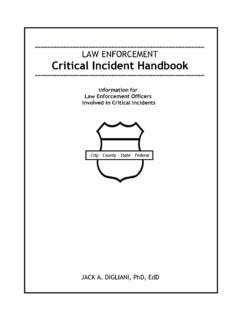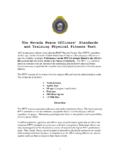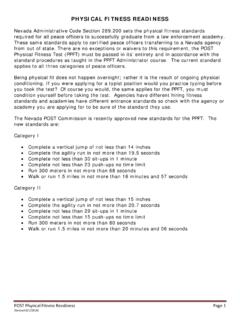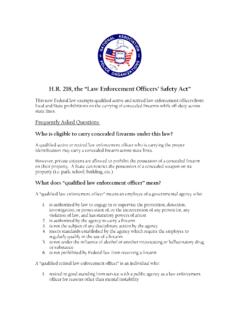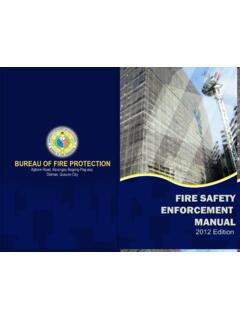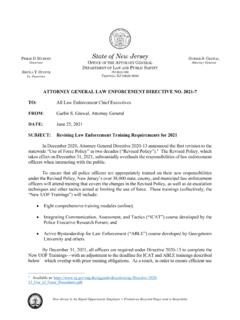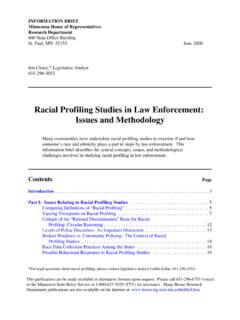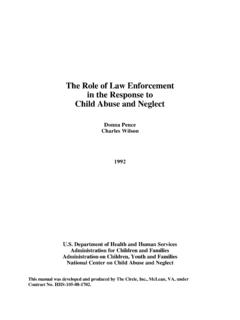Transcription of LAW ENFORCEMENT Critical Incident Handbook
1 LAW ENFORCEMENT Critical Incident Handbook JACK A. DIGLIANI, PhD, EdD Information for Law ENFORCEMENT Officers Involved in Critical Incidents City - County - State - Federal LAW ENFORCEMENT Critical Incident Handbook Also by Jack A. Digliani: Stress Inoculation: The Police Reflections of a Police Psychologist Police and Sheriff Peer Support Team Manual Firefighter Peer Support Team Manual Copyright 2012 by Jack A. Digliani, PhD, EdD Permission is granted for the copying and distribution of this Handbook . Printed in the United States of America October 11, 2012 TaLkD25aEpS Law ENFORCEMENT Critical Incident Handbook E-Version The Law ENFORCEMENT Critical Incident Handbook is designed to provide concise and practical information to officers that have recently experienced a Critical Incident . It also includes information useful to spouses and police agencies planning to develop Critical Incident protocols.
2 If you are a police officer reading this and your department does not have a support program for officers that have experienced a Critical Incident , I encourage you to contact your administrators and initiate a dialog about creating a professional and peer support Critical Incident protocol. The Handbook includes information from the Police and Sheriff Peer Support Team Manual and Reflections of a Police Psychologist. The topic items of the Handbook are designed so that they may be used independently of one another. Therefore, some information pertinent to the topic title may appear in more than one document. The Handbook is intended to be a companion publication to Reflections of a Police Psychologist. A two-sided print of the Handbook E-version is recommended. To order Reflections of a Police Psychologist contact: For further information about police psychology and officer wellness, or to download a free copy of the Police and Sheriff Peer Support Team Manual visit the following websites: or Law ENFORCEMENT Critical Incident Handbook Contents Introduction 1 Critical Incidents and Traumatic Stress Critical and Traumatic Incidents 3 Critical Incident Information 4 Posttraumatic Stress, PTSD, and Acute Stress Disorder 5 Traumatic Stress.
3 Shock, Impact, and Recovery Stronger and Smarter 6 Option Funnel verses Threat Funnel 7 Critical Incident Issues, Strategies, and Concepts 8 Incident Debriefing Information 9 Police officer Danger, Unavoidable Stressors, and Confrontation 10 25 Suggestions and Considerations for Officers Involved in Critical Incidents 11 Suicide by Cop 14 Witness to Suicide 15 Exposure to Injury, Death, and Death Imprint 16 Death, Loss, and Survivorship 18 Police Department Protocol Critical Incident Management and Return to Duty Protocol 19 Trauma Intervention Program 21 Fitness for Duty Evaluation, officer Wellness Assessment, and the TIP 22 officer -Involved Incident Protocol The Police officer Involved 24 Police officer and Family Wellness Recovering from Traumatic Stress 26 Trauma: Chronological History and Psychological History 27 Officers and Spouses: Critical Incident Information 28 Police Spouse Anxiety and Critical Incidents 29 Foundation Building Blocks of Functional Relationships 30 Life Management.
4 Life by Default Life by Design 32 Keeping Yourself Healthy 33 Stress and Stress Management The Concept of Stress 34 Signs of Excessive Stress 36 Stressor Related Disorders DSM 37 Some Things to Remember 38 Information Warning Signs of Alcoholism Information 39 Police officer Suicide Risk Factors 41 Action Plan Worksheet 42 Comprehensive Model for Police Advanced Strategic Support (COMPASS) 44 officer Notes 46 About the Author 47 Jack A. Digliani, PhD, EdD Page 1 Law ENFORCEMENT Critical Incident Handbook Introduction Law ENFORCEMENT officers have much in common. Most are committed to the ideals of serve and protect and will risk their lives in service to their community. There is a proud history of law ENFORCEMENT in America. It is a history of service and sacrifice.
5 Every officer knows the dangers involved in policing. All too familiar to police officers is the fact that there are some persons that will intentionally act to harm or kill police officers. The dangers inherent in policing create the need for officer -safety procedures, self-defense weaponry, and self-defense tactics. At times, police officers have no choice but to defend themselves. In self defense, many officers have had to utilize deadly force to keep from being seriously injured or killed. Although there are many kinds of police Critical incidents, if you have had to use deadly force to defend yourself or someone else, you have experienced one of the most challenging types of police Critical incidents. These can vary greatly in perceived intensity and can affect officers in a number of different ways. For police officers there is an increased probability of exposure to Critical incidents. This is because of the kind of work police officers do and the role that police officers play in our society.
6 Police officers know and accept this unavoidable stressor of policing. During and following a Critical Incident A Critical Incident can produce out-of-the-ordinary perceptual phenomena. The experience of vivid images is one such phenomenon. Vivid imagery differs from hallucination in that there is an actual environmental stimulus involved in the perception. Consider the real-life case of officer M. officer M experienced vivid imagery during the Incident and hallucination the following day: officer M responded to a call of a disturbance and found himself in a backyard, face to face with a seventeen year old suspect armed with a butcher knife. officer M drew his weapon and ordered the suspect to drop the knife. The suspect did not comply and began walking toward the officer . As he was walking, the suspect began shouting shoot me, shoot me! officer M, hoping to bring about a non-lethal resolution, began backing away from the suspect.
7 By backing away, he could keep himself safe without having to shoot the young man. As the suspect continued his advance, the suspect unexpectedly drew the knife across his forehead. This caused profuse bleeding. officer M could barely see the suspect s face. officer M retreated until he was backed into a corner, between a fence and a wood pile. He continued trying to reason with the young man. When he could not withdraw any further, he advised the suspect that if his advance continued, he would have to shoot him. The suspect was now approximately seven feet from the officer , still holding the knife. officer M began to pull the trigger of his weapon. It was pointed directly at the suspect s chest. officer M recounted, My thoughts were at Mach I, but everything else was moving super slow. He remembered seeing the hammer of his weapon cocking back in preparation for firing. At this instant, several things happened. (1) Although the suspect was wearing a shirt, officer M saw the suspect as bare-chested.
8 He also observed two bullet holes in the suspect s bare chest. This was despite the fact that the suspect was still wearing a shirt and officer M had not fired his weapon. (2) Thoughts began to run through officer M s mind. The first thought was Why is this weapon not firing? (3) He thought of his children. They were close to the age of the suspect. What would they think of their father killing someone so close to their age? About this time, the suspect stopped and dropped the knife. He surrendered. To this day it Jack A. Digliani, PhD, EdD Page 2 Law ENFORCEMENT Critical Incident Handbook remains unclear why. Maybe his anger and frustration had run its course. Maybe he realized that he did not want to die. Whatever the reason, the suspect had come very close to being killed by an officer who had literally run out of options. Once the suspect surrendered, Office M reported that everything snapped back to the present reality. His thoughts and perceptions returned to normal.
9 The suspect was taken into custody, not shot and still wearing his shirt. The next day, officer M was in the shower. He was thinking about the Incident and the strange experiences of the day before. Suddenly and to his surprise, he again saw the image of the bare-chested suspect. Again, there were two bullet holes in the chest. The image was so clear that it was like a photograph. He was instantly overcome by a deep sadness. He remembered, Feelings flooded my body like I killed him, like I had done a horrible, horrible thing. He thought I m a cop. I shouldn t be feeling this way. He wondered where this image and these feelings were coming from. How were they even possible? He could not get the image out of his mind. He recalled that he thought he was going crazy. He considered quitting policing. Visual hallucinations and vivid images are more common than believed in traumatic situations. Although the exact cause of such experiences is unknown, there is some speculation that it is related to increased levels of cortisol, a stress response hormone.
10 Many persons are reluctant to report hallucinations and vivid images for fear of being perceived as mentally ill or psychotic. If fact, they are neither. Visual hallucinations and vivid images are part of the brain s reaction to traumatic events. In most cases, they are short lived. For officer M, the image and associated feelings disappeared soon after seeking professional treatment. (From Digliani, Reflections of a Police Psychologist, pages 71-72, 2010) There (1) There are many variables that determine how an officer is affected by involvement in a Critical Incident . Some of these are presented in Critical and Traumatic Incident . (2) There are various possible responses to a Critical Incident . These are presented in Critical Incident Information. (3) There are many things that police agencies can do to minimize the possible undesirable effects of a Critical Incident . Professional and peer support is important. Agency support should begin in the police recruit academy and continue throughout an officer s career.
